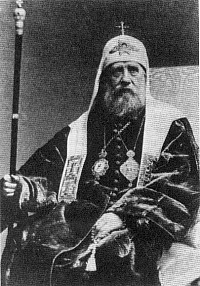Saint Tikhon the Confessor and Patriarch of Moscow
Saint Tikhon, Confessor and Patriarch of Moscow, was born Vasily Ivanovich Bellavin on January 31st (January 19th o.s.), 1865. His father was Ioann Belavin, a rural priest of the Toropetz district of the Pskov diocese. From his early years he displayed a particular religious disposition, love for the Church as well as rare meekness and humility. From 1878 to 1883, Vasily studied at the Pskov Theological Seminary. His fellow students liked and respected him for his piety, brilliant progress in studies, and constant readiness to help comrades, who often turned to him for explanations of lessons, especially for help in drawing up and correcting numerous compositions. In 1888, at the age of 23, he graduated from the Saint Petersburg Theological Academy as a layman. He then returned to the Pskov Seminary and became an instructor of Moral and Dogmatic Theology. In 1891, at the age of 26, he took monastic vows and was given the name Tikhon in honor of St Tikhon of Zadonsk. Tikhon was consecrated Bishop of Lublin on October 19th, 1897. On September 14th, 1898, he was appointed Bishop of the Aleutians and Alaska. As head of the Russian Orthodox Church in America he reorganized the diocese and changed its name from "Diocese of the Aleutians and Alaska" to "Diocese of the Aleutians and North America" in 1900. While living in the United States Archbishop Tikhon was made a citizen of the United States.
He had two vicar bishops in the United States, Bishop Innocent (Pustynsky) in Alaska, and Bishop (Saint) Raphael (Hawaweeny) in Brooklyn. In June 1905, Archbishop Tikhon gave his blessing for the establishment of St Tikhon's Monastery in Pennsylvania. On May 22nd, 1901, he blessed the cornerstone for St Nicholas Cathedral in New York. He was also involved in establishing other churches in North America. On November 9th, 1902, he consecrated the church of St Nicholas in Brooklyn for the Syrian immigrants. Two weeks later, he consecrated St Nicholas Cathedral in New York.
In 1907 he returned to Russia, and was appointed Bishop of Yaroslavl. He was transferred to Vilnius, Lithuania December 22nd, 1913, and on June 21st, 1917, he was elected the ruling bishop of Moscow by the Diocesan Congress of clergy and laity. On August 15th, 1917, Archbishop Tikhon was raised to the dignity of Metropolitan of Moscow. On November 5th of the same year, after an election as one of the three candidates for the reinstated Moscow Patriarchate, Metropolitan Vladimir of Kiev announced that Metropolitan Tikhon had been selected for the position after a drawing of lots as the new Patriarch of the Russian Orthodox Church.
During the Russian Civil War the Patriarch was widely seen as anti-Bolshevik and many members of the Orthodox clergy were imprisoned or executed by the new regime. Patriarch Tikhon openly condemned the killings of the tsar's family in 1918, and protested against violent attacks by the Bolsheviks on the Church.
During the famine in 1922 the Patriarch was accused of being a saboteur by the Communist government, for which he was imprisoned from April 1922 until June 1923 in Donskoy Monastery. Among acts incriminating him was his public protest against nationalization of the property of the Church. This caused international resonance and was a subject of several notes to the Soviet government.
Under pressure from the authorities, Patriarch Tikhon issued several messages to the believers in which he stated in part that he was "no longer an enemy to the Soviet power". Despite his supposed declaration of loyalty, he continued to enjoy the trust of the Orthodox community in Russia. In 1923 Patriarch Tikhon was "deposed" by a Soviet-sponsored council of the so-called Living Church, which decreed that he was "henceforth a simple citizen—Vasily Bellavin." No canonical church has ever recognized this deposition as an act of the Russian Orthodox Church.
When the sewer system under the hastily erected Mausoleum of Lenin was damaged and a leak occurred, St Tikhon remarked, "The balm accords with the relics". The phrase was widely quoted.
In 1924 the Patriarch fell ill and was hospitalized. On April 5th, 1925, he served his last Divine Liturgy, and died two days later, on April 7th (March 25th o.s.), the Feast of the Annunciation. He was buried on April 12th in the winter church of Donskoy Monastery in Moscow. From the time of his death, he was widely considered a martyr or confessor for the faith.
Patriarch Tikhon was glorified (canonized) a saint by the Synod of Bishops of the Russian Orthodox Church Outside Russia in conjunction with the great glorification of the New Martyrs and Confessors of the Soviet Yoke on November 1st (October 19th o.s.), 1981. He was later glorified by the Moscow Patriarchate during the Bishop's Council of October 9th to 11th, 1989. This later canonization process is generally considered an example of the thaw in Church-Soviet relations during the Glasnost era.
St Tikhon's relics were believed lost, but on February 19th, 1992 (or, according to another source, February 22nd), they were discovered in a concealed place in the Donskoy Monastery and were found to be almost entirely incorrupt. The relics were placed in a reliquary and on April 5th (March 23rd o.s.), 1992, fifty bishops solemnly transferred them to the Katholikon (main church) of the Donskoy Monastery in a place of honor by the soleas.
|
|
|
